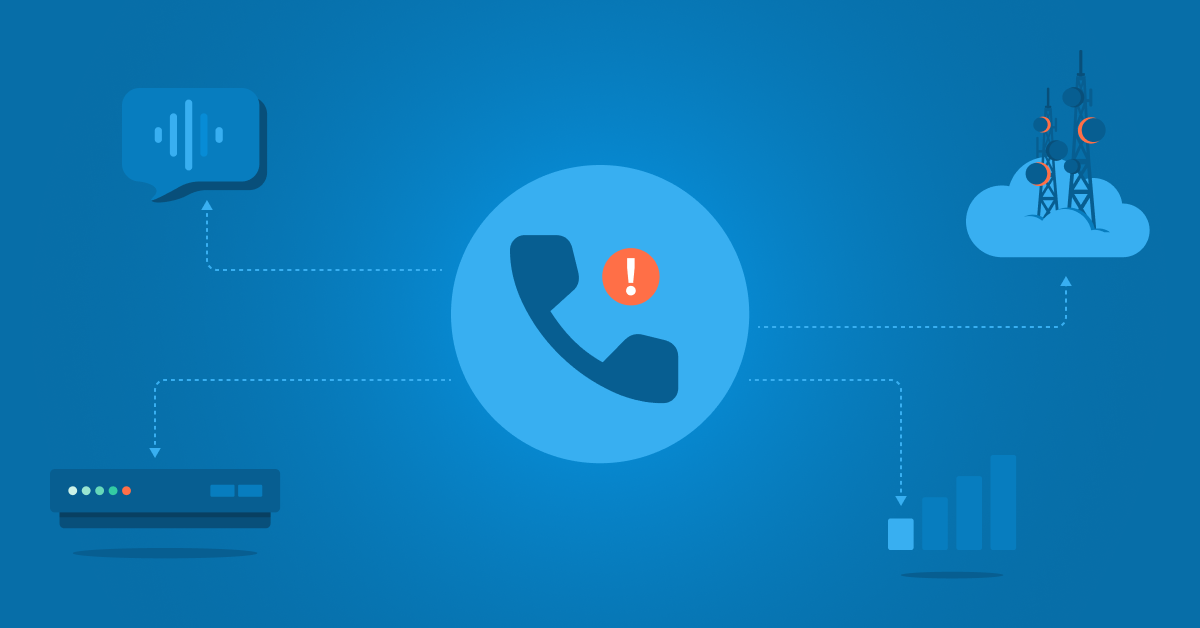Has your business ever been on the phone with a client and their voice starts breaking up? Or worse–the line drops? To top it all off, maybe your monitor starts to flicker too. Don’t worry, it’s not a ghost behind your screen.
It’s just network jitter.
This guide will define what network jitter is, walk you through some common examples your business has probably already encountered, and explain what causes network jitter–and, most importantly–how to fix it.
What is network jitter?
Your computer or mobile device communicates with the internet by transmitting pieces of data called packets. These packets need to be sent at regular intervals to be best understood. Jitter occurs when there are any irregularities in sending those packets. Any signal changes in amplitude, width, or phase timing is considered jitter.
The slower the packet flow, the worse the jitter–and that bad jitter is what causes your business’ call to drop.
Every device can handle jitter up to a certain level. Small amounts can result in audio irregularities on voice calls. When small amounts of jitter take place over voice over internet protocol (VoIP), they result in network congestion, which can slow down interactions with the internet.
When your company is having network jitter problems while talking with family and friends, it can be annoying. When your workers can’t communicate with their remote colleagues, it’s a problem.
VoIP jitter can be a big issue for online work calls. When you’re talking with a colleague or client using a VoIP connection, your voice is broken into data transmitted over data packets. If those data packets are delayed or missing, you become unintelligible. This is why it’s so important to pick a reliable VoIP provider.
Before we go any further, let’s address some other common types of jitter your business might encounter:
Common types of jitter include:
Constant jitter
This kind of jitter results in a constant level of packet-to-packet delay variation.
Short-term delay variation
This type of jitter results in an increased packet delay. Congestion and route delays often occur because of these delays.
Transient jitter
This type of jitter causes delays because of a single packet.
Understanding the type of network jitter your business is experiencing can help you better understand what is causing that jitter, and how to prevent it.
Enterprise Communications Landscape 2024
Hear how 1,000 IT leaders are improving call quality and fighting jitter.

What causes jitter?
Now that you know how to identify what kind of network jitter your company might be facing, let’s discuss what exactly causes it.
Jitter can be caused by a variety of issues, which can make it difficult to troubleshoot. Consider reviewing the following when trying for fixes:
- Wireless network jitter is a common culprit. Wireless networks are great for mobility, but a lack of cords means an inferior network connection. If you’re currently wireless, consider using a wired connection to improve voice and video conversations.
- Insufficient bandwidth can cause jitter when the network is too crowded. This means either too many people are using your business’ network, or the network is under a heavy load (like video streaming).
- If packet prioritization is not implemented you might suffer from jitter. Most modern VoIP systems will automatically prioritize audio data over other kinds of traffic. This means that while your video might lag, you’ll still be able to hear the person you’re talking to. If audio data hasn’t been prioritized, communication will suffer when jitter occurs.
- Outdated equipment like cables or routers, can cause network jitter. We’ll get into why below.
How is jitter measured?
Jitter is measured by calculating the average packet-to-packet delay time. The way you measure things varies depending on the type of traffic your business has. The following are common tests:
Double endpoint
This test measures the variation between transmitting and receiving intervals for one packet, measuring instantaneous jitter.
Single endpoint
Also known as a ping jitter test, this measurement calculates the mean round-trip time (RTT) and minimum RTT of a group of voice packets. The amount of time it takes for a pulse or packet to travel from one source to another and back again is the RTT.
Bandwidth test
Bandwidth tests evaluate the download and upload speed of internet connection. Speeds are measured in kilobits per second (Kbps) or megabits per second (Mbps). These tests determine the level of jitter times and the overall network capacity.
The bandwidth test is the easiest way for a business to test jitter, as it tells users if their internet provider is the main culprit behind their high jitter levels.
However, the results of this test can be difficult to measure. Other factors like internet traffic, file size, and server load demand can affect Kbps and Mbps. This means bandwidth tests should be conducted multiple times to get an average (and more accurate) picture of jitter.
Is there an acceptable jitter amount?
Yes! Acceptable jitter levels mean your company and workers likely won’t notice any changes in your phone connection.
The ideal amount of jitter should be below 30 milliseconds. Any higher than that, you’ll start to experience distortion when on calls. Network latency should be less than 150 ms one way and below 300 ms RTT. Packet loss should never exceed 1%.
It’s the same for video streaming; jitter should be below 30 milliseconds. If you exceed 30 milliseconds, calls can be delayed or dropped, and you might encounter problems with static or audio distortion.
Though jitter levels below 30 milliseconds usually aren’t noticeable, this varies depending on devices. Some servers have higher jitter tolerance. It also depends on what your business is using their devices for; jitter is hardly noticeable when one is sending out emails, but can be an issue on video calls.
How to prevent network jitter
Now that we’ve discussed the different kinds of jitter and you know how to measure the amount your business is currently experiencing, let’s walk through some common fixes so we can get you (back) up to speed:
Test the quality of your internet connection
If your company has a bad internet connection, you’re likely going to have high jitter. If you find your internet provider to be the culprit, consider upgrading to a superior package, or switching to another provider.
Prioritize packet flow
As we discussed before, packet flow prioritization can help a lot with VoIP calls. Depending on your router, your business might be able to prioritize audio packets over other kinds of traffic. This solution will work best if customer calls keep dropping, and you want to put priority on those calls instead of other internet traffic.
Upgrade your tools
If you’re working with old tools, buying a new ethernet cable is an easy fix to address jitter. New cables can help because they can transmit 250 megahertz (MHz) of data–as opposed to old cables, which transmit data at 125 MHz.
You can also invest in a better internet router. Higher-quality routers will always prioritize voice traffic over network traffic. Always research if the router can handle the bandwidth necessary for your office.
Schedule system updates outside of working hours
Another easy, cost-effective jitter fix is to schedule application and operating system updates outside of working hours. That means far less traffic–and less strain–on your system when you’re trying to get stuff done.
Use jitter buffering
Jitter buffers can reduce jitter effects. Applications (like your Google Meet call when you’re trying to talk to a client) receive network packets from the buffer, instead of receiving them directly. The buffer feeds packets at a regular rate, smoothing packet irregularities.
Find a reliable VoIP or UCaas Provider to reduce jitter
The quality of your business’ VoIP provider can also impact the amount of jitter on your network. A reliable VoIP provider can provide HD video conferencing and high-quality voice and video calls. You can also consider unified communications (also known as UC or UCaaS, unified communication as a service) providers instead.
Where a VoIP provider provides only a cloud-based phone system, a UCaaS provider has an omnichannel experience. Both providers are cloud-based, but UCaaS is usually a better choice for bigger businesses, as it’s more cost effective, has better customer support, and, most importantly, provides multiple communication channels.
If you’re having VoIP jitter issues and have more than one communication channel, you can choose to route high-priority traffic on the faster channel, and avoid any issues. Learn what’s better for your business, a VoIP provider or a UCaaS provider, by talking to an expert.
Try Bandwidth’s voice
Streamline and expand globally with a universal, trusted voice carrier.




